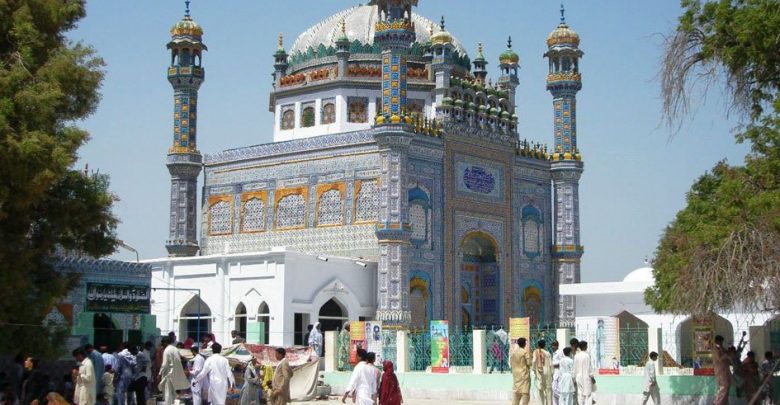Crimes at Shrines:

By Qasim Swati (United Kingdom)
A shrine is a place regarded as holy because of its associations with a divinity or a sacred person or relic, marked by a building or other construction. It is a place of worship that is holy because of a connection with a holy person or object or it is a special place in which you remember and praise someone who has died, particularly someone famous. A shrine can also be referred to as a sacred or holy place, dedicated/devoted to a particular or specific saint, hero, daemon (originally referred to a lesser deity or guiding spirit, it is a Latin word for the Ancient Greek daimon), martyr, ancestor, deity or such other figure of respect, wherein they are worshipped or revered/honoured.
The existence of shrines is not limited and restricted to a specific religion or part of the world. Instead, they can be found in most of the world’s religions, such as Buddhism, Christianity, Judaism, Hinduism, Sikhism, Islam, Asatru (Germanic paganism), Shinto (also known as Kami-no-michi or Shintoism, originating from Japan) and Chinese folk religion. We can find shrines in different forms or settings, like cemeteries or graveyards, temples, museums, churches and such other places.
In Islam, the various terms used for shrines include Dargah (a shrine built over the graveyard of a religiously respected and revered personality, mostly a dervish or Sufi saint); Maqam (a sort of a shrine built on the site, connected with a Muslim religious figure or saint, mainly his or her tomb); Mazar (a shrine or mausoleum, typically the one associated with a famous national or religious leader or a saint), and Mashad or Darih (referred to shrines in Medieval Arabic texts, denoting the same meaning).
Similarly, a saint is a person acknowledged as holy or virtuous and regarded in Christian faith (and also in other religions) as being in heaven after death. The same word, informally, is used for a very kind, virtuous, or patient person as well. A saint is someone being recognized to have a closeness or likeness to God or an exceptional degree of holiness.
Due to the massive scope of the ongoing topic, this article is limited to crimes, associated with shrines, in Pakistan only. Like other religions of the world, there are many saints in Islam where the Muslims are not lagging behind in the race of boasting about their huge list of holy and religiously-thought-to-be-good people, commonly known as ‘saints’ or ‘Awliya’ in Urdu and Arabic.
Sufi saints or ‘Awliya’ (singular ‘Wali’) have played an enormous role in propagating and preaching the teachings of Islam. However, those associated with shrines abuse and exploit the good name, fame, holiness and sacred history and achievements of these saints and misguide, rob, cheat, deceive and manipulate the ordinary people in different ways for their own selfish benefits. Those responsible for abusing the system of mysticism include such people, as the self-proclaimed claimants of shrines or self-declared inheritors of these saints, monopolists, fake or Jali Peers, false and fraudulent Mujawars, bogus Malangs and such other mafia, associated with shrines, located in various parts of Pakistan.
A Mujawar, according to a source from India, is of Indian (Sanskrit) origin, which means “Worshipper (Brahmin”), while the word ‘Malang’ is described in J. L. Lee’s Ancient Supremacy as someone, like a religious mystic, often with heterodox or extreme Sufi tendencies; or a shrine attendant, which also means someone who does not care much about his surroundings, or a person who is not a worldly person, despite living in this world).
There are many shrines in Pakistan, but Sumayia Asif has given a list of the 10 Most Visited Shrines in Pakistan in The Express Tribune (a daily English-language newspaper based in Pakistan) on November 02, 2015 that include the Tomb of Shah Shamas Tabreze (Multan), the Shrine of Hazrat/Hadhrat Bahauddin Zakariya (Multan), the Shrine of Hazrat Muhammad Shah Yusaf Gardezi (Multan), the Shrine of Khawaja Ghulam Farid, Mithankot/Kot Mithan (Rajanpur), the Tomb of Bibi Jawindi, Uch Sharif (Punjab), the Shrine of Data Ganj Bakhsh (Lahore), the Shrine of Lal Shahbaz Qalandar (Sehwan Sharif), the Shrine of Hazrat Shah Rukn-e-Alam (Multan), the Shrine of Sachal Sarmast (Khairpur), and the Shrine of Abdullah Shah Ghazi (Karachi).
These Sufis (a Sufi being someone as a Muslim ascetic and mystic), mystics, saints and religiously revered people have made many sacrifices by playing a great role in spreading and preaching of Islam, especially in the Indo-Pak subcontinent and are still respected a lot, but there are certain people who misinterpret their teachings and try to misguide ordinary people by manipulating them in different ways for achieving their own individual and vested interests.
Such people have full monopoly and control over the affairs of these shrines by claiming to be offspring, relatives, disciples and followers of these saints and mystics. They also claim of having and possessing the power of remedies for the spiritual, physical, psychological, emotional, financial and such other problems of the people.
Accordingly, a large number of simple, straightforward and sincere men, women, girls, young boys, elderly people and even children visit these shrines or such other places where the claimants and self-proclaimed inheritors of these mystics do their business in the name of religion, spiritual purification and mystical practices.
The innocent ordinary people (the pilgrims and visitors of these shrines) use their time, wealth, energy and other resources for seeking solution to various problems that they are faced with in their daily lives, and visit these shrines and/or the monopolists and self-proclaimed claimants of such religious sites in the hope to get rid of their hardships and sufferings and also to boost their spiritual wellbeing, but, unfortunately, these people end up with becoming the victims of sexual harassment, sexual assaults, rape, and getting robed , deceived, cheated and exploited at the hands of their exploiters, thus, losing both their honour, wealth and self-esteem.
Instead of being centres for religious training and spiritual betterment, these shrines have become the dens of sex, and a main source of power for these monopolists of the shrines to abuse, manipulate and misguide frank, candid and honest people and also the centres of anti-religious and anti-Islamic practices and many other shameful, deplorable, disgraceful and despicable activities.
Above all, these self-declared claimants or self-proclaimed inheritors and monopolists of these shrines and mystics benefit a lot from the existence of these religious places and have become very rich, with lots of powers and influence, in society, because most of these shrines have huge revenues and income.
Qasim Swati is a freelance journalist, writer and human rights activist, based in the UK, and can be reached at https://qasimswati.com or mailto:info@qasimswati.com.

